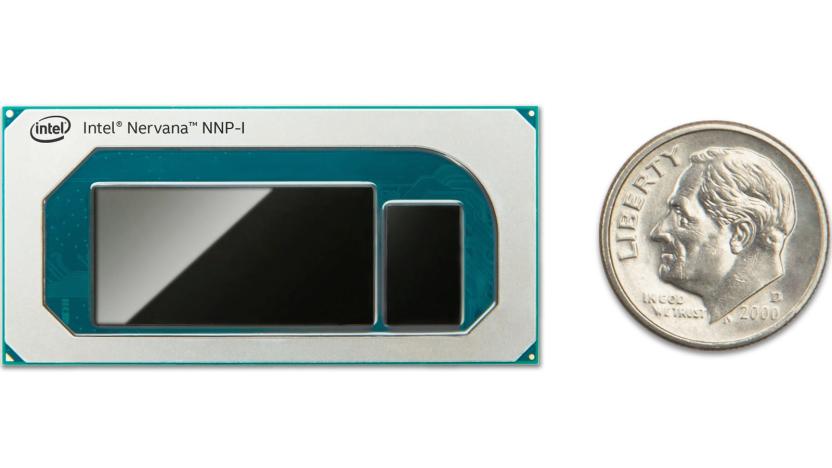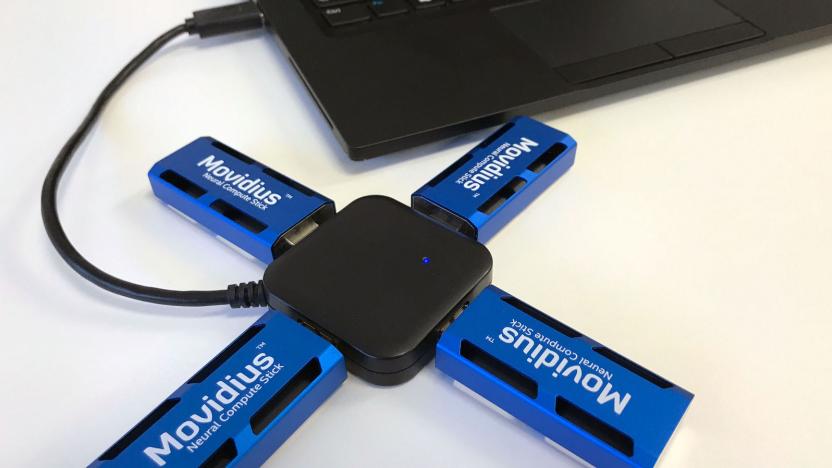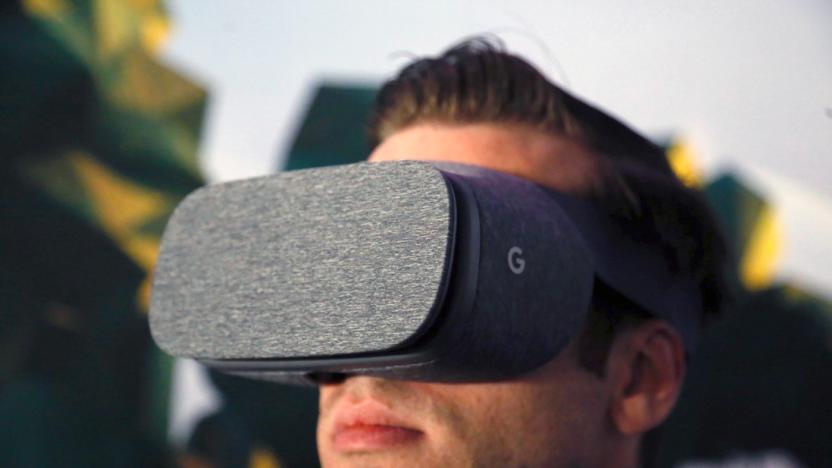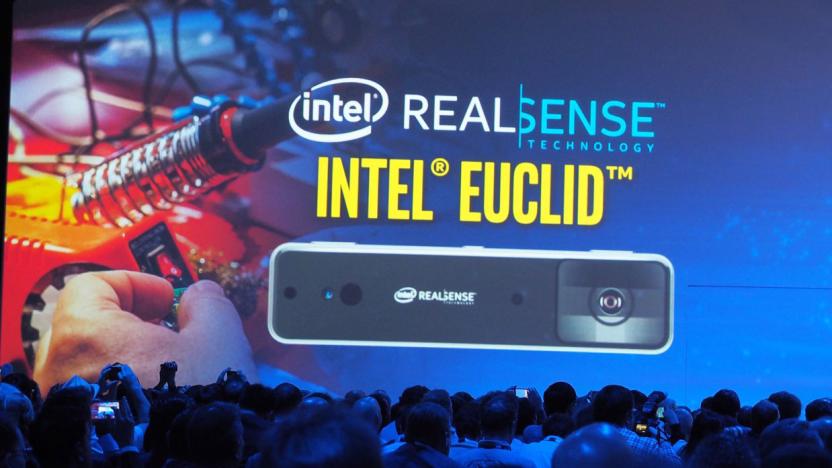movidius
Latest

Intel unveils its first chips built for AI in the cloud
Intel is no stranger to AI-oriented chips, but now it's turning its attention to those chips that might be thousands of miles away. The tech firm has introduced two new Nervana Neural Network Processors, the NNP-T1000 (below) and NNP-I1000 (above), that are Intel's first ASICs designed explicitly for AI in the cloud. The NNT-T chip is meant for training AIs in a 'balanced' design that can scale from small computer clusters through to supercomputers, while the NNP-I model handles "intense" inference tasks.

Intel RealSense tracking camera helps robots navigate without GPS
Intel is back with another RealSense camera, but this one has a slight twist: it's meant to give machines a sense of place. The lengthily-titled RealSense Tracking Camera T265 uses inside-out tracking (that is, it doesn't need outside sensors) to help localize robots and other autonomous machines, particularly in situations where GPS is unreliable or non-existent. A farming robot, for instance, could both map a field as well as adapt on the fly to obstacles like buildings and rocks.

Intel-powered camera uses AI to protect endangered African wildlife
Technology is already in use to help stop poachers. However, it's frequently limited to monitoring poachers when they're already in shooting range, or after the fact. The non-profit group Resolve vows to do better -- it recently developed a newer version of its TrailGuard camera that uses AI to spot poachers in Africa before they can threaten an endangered species. It uses an Intel-made computer vision processor (the Movidius Myriad 2) that can detect animals, humans and vehicles in real-time, giving park rangers a chance to intercept poachers before it's too late.

Intel’s Myriad X chip will give drones and robots better vision
It's been almost a year since Intel scooped up AI and computer vision chip-maker Movidius. By the time of its takeover, the company had already crammed its Myriad 2 processor into drones, cameras, and USB sticks -- making it a good fit for Intel's beyond-the-PC strategy. The newly-unveiled successor to that chip will continue in the same vein. Only, this next-gen beast is the first to pack a "Neural Compute Engine." What that essentially means is that it has some pretty powerful deep learning capabilities. If Intel gets its way, the Myriad X chip will help drones, smart cameras, and robots to learn from and interact with their surroundings in real-time.

Intel puts Movidius AI tech on a $79 USB stick
Last year, Movidius announced its Fathom Neural Compute Stick — a USB thumb drive that makes its image-based deep learning capabilities super accessible. But then in September of last year, Intel bought Movidius, delaying the expected winter rollout of Fathom. However, Intel has announced that the deep neural network processing stick is now available and going by its new name, the Movidius Neural Compute Stick. "Designed for product developers, researchers and makers, the Movidius Neural Compute Stick aims to reduce barriers to developing, tuning and deploying AI applications by delivering dedicated high-performance deep-neural network processing in a small form factor," said Intel in a statement.

AI-powered security cameras recognize small details faster
San Mateo-based Movidius may still be in the process of getting bought up by Intel, but the company's latest deal will put its low-power AI and computer vision platform into more than just DJI drones and Google VR headsets. The company announced today that the Movidius Myriad 2 Video Processing Unit (VPU) will soon power a new generation of Hikvision smart surveillance cameras capable of recognizing everything from suspicious packages to distracted drivers.

Google's VR future includes a headset that tracks your eyes
Google's plans for a new headset are advancing. In July, we wrote that Google had been actively assigning individuals to work on a high-end standalone headset that doesn't require a computer or smartphone. In the three months since, people familiar with the matter have told Engadget that Google's device will integrate eye tracking and use sensors and algorithms to map out the real-world space in front of a user.

Intel buys Movidius to build the future of computer vision
Intel is making it extra-clear that computer vision hardware will play a big role in its beyond-the-PC strategy. The computing behemoth has just acquired Movidius, a specialist in AI and computer vision processors. The Intel team isn't shy about its goals. It sees Movidius as a way to get high-speed, low-power chips that can power RealSense cameras in devices that need to see and understand the world around them. Movidius has already provided the brains behind gadgets like drones and thermal cameras, many of which are a logical fit for Intel's depth-sensing tech -- and its deals with Google and Lenovo give nothing to sneeze at, either.

ICYMI: AI in a USB stick, electric bike wheel and more
#fivemin-widget-blogsmith-image-784522{display:none;} .cke_show_borders #fivemin-widget-blogsmith-image-784522, #postcontentcontainer #fivemin-widget-blogsmith-image-784522{width:570px;display:block;} try{document.getElementById("fivemin-widget-blogsmith-image-784522").style.display="none";}catch(e){} Today on In Case You Missed It: Chip maker Movidius created an advanced neural networks USB stick to put AI into any device; the GeoOrbital wheel turns any dumb bike into a 20 miles per hour powerhouse; and Samsung has a pilot program to put a mother's heartbeat into her premature baby's incubator. An open source robot used for research is also really good at yoga. As always, please share any great tech or science videos you find by using the #ICYMI hashtag on Twitter for @mskerryd.

Artificial intelligence now fits inside a USB stick
Movidius chips have been showing up in quite a few products recently. It's the company that helps DJI's latest drone avoid obstacles, and FLIR's new thermal camera automatically spot people trapped in a fire, all through deep learning via neural networks. It also signed a deal with Google to integrate its chips into as-yet-unannounced products. Now, the chip designer has a product it says will bring the capacity for powerful deep learning to everyone: a USB accessory called the Fathom Neural Compute Stick.

AI-powered cameras make thermal imaging more accessible
As cool as thermal cameras may be, they're not usually very bright -- they may show you something hiding in the dark, but they won't do much with it. FLIR wants to change that with its new Boson thermal camera module. The hardware combines a long wave infrared camera with a Movidius vision processing unit, giving the camera a dash of programmable artificial intelligence. Device makers can not only use those smarts for visual processing (like reducing noise), but some computer vision tasks as well -- think object detection, depth calculations and other tasks that normally rely on external computing power.

Google's latest partnership could make smartphones smarter
Google has signed a deal with Movidius to include its Myriad 2 MA2450 processor in future devices. The search giant first worked with Movidius back in 2014 for its Project Tango devices, and it's now licensing the company's latest tech to "accelerate the adoption of deep learning within mobile devices."

Movidius wants to change the way your smartphone sees the world
Despite the promise of Google's Movidius-equipped Project Tango, there are still no depth-sensing, SLR-stomping smartphones on the market. But Movidius thinks that could change soon, thanks to its brand new chip: the Myriad 2 vision processor unit (VPU). "The Myriad 2 is going to provide more than 20x the power efficiency of the Myriad 1, and enable camera features that were not possible before in mobile devices," CEO Remi El-Ouazzane tells me. If you'll recall, Tango's original tech brought faster focus, improved depth of field, near-optical zooming and higher light sensitivity to smartphone cameras (and now, tablets). It also let researchers scan a room in 3D to provide interior navigation, among other cool tricks.

Project Tango teardown reveals the wonders of the phone's 3D sensing tech
Want to get a better understanding of Google's 3D-sensing Project Tango smartphone beyond the usual promo videos? iFixit is more than happy to show you now that it has torn down the device for itself. The close-up identifies many of the depth mapping components in the experimental handset, including the infrared and fisheye cameras (both made by OmniVision), motion tracking (from InvenSense) and dual vision processors (from Movidius).

The next mobile imaging war won't be waged over megapixels
For the past several years, improvements in smartphone cameras have followed the "more megapixels" mantra. Samsung's Galaxy S5 is up from 13 to 16 megapixels; Sony's new Xperia Z2 packs a 20.7-megapixel Exmor model; and Nokia's Lumia 1020 with PureView is a 41-megapixel monster. However, Google's recent sensor-laden smartphone prototype, Project Tango, could herald a new direction. Though Mountain View is focused on 3D mapping, so-called depth camera tech could dramatically improve all the pictures you take with your smartphone. By using two lenses with different focal lengths, for example, you could zoom in on subjects with quality that rivals bulky optical zooms. It could also eliminate a number of other shortcomings without adding an awkward hump like the one seen on the Lumia 1020. You could soon have much better light sensitivity, less noise and depth of field control that rivals a DSLR. The benefits are clear, but Google is not alone in its pursuit. The battle for a better smartphone camera is on, and you could be the one to reap the rewards.





